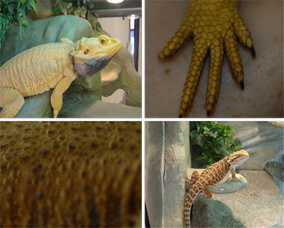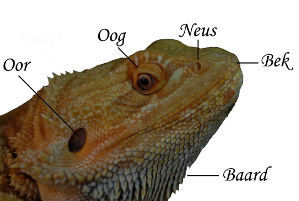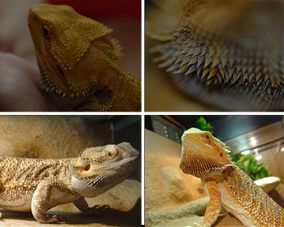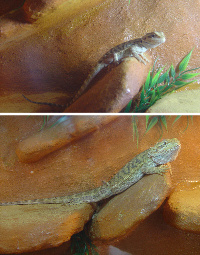
Description
The bearded dragon is a Horned Lizard, which belongs to the family aganmen. The bearded Dragon lives in desert regions.
Like all reptiles, bearded dragons are cold-blooded animals. Cold-blooded means, that the animal itself does not have the capacity to produce its own body heat, unlike a warm-blooded animal. Controlling the body-temperature is also called thermo regulation. The regulation of the body temperature depends on behavior as looking up warmer or cooler places. Other known cold-blooded animals are are fish, snakes, frogs and arthropod ect.
They are dependent on the temperature of environment. Once they are warmed up in the sun, they can get really active. Without heat they are less active. So it´s important to regulate the temperature in the terrarium.
Stature

The bearded dragon is a vigorous built lizard. The body of a bearded dragon is well muscled and altogether they can grow 56 cm long. (body average is 25 cm, and tail up to 31 cm long).
The adult bearded dragon usually weighs between 400 to 600 grams. The legs are short and very powerful.
Bearded dragons have a spiky, scaly skin. Nowadays the Pogona Vitticeps comes in all kinds of (farmed) colour variation.
Head /Beard
 The young bearded dragons have a relative small "like, frog cups" head. As they grow older the head will form into a beautiful characteristic head, which is kind of triangular shaped and relatively large and stub.
The young bearded dragons have a relative small "like, frog cups" head. As they grow older the head will form into a beautiful characteristic head, which is kind of triangular shaped and relatively large and stub.
The bearded dragon is characterized by its beard (throat) that can be fully extended. The eyes are on the side of the head, therefore the field of view limited. The eyelids are apparent. On either side of the head can also be seen a small hole with a kind of film is behind (the eardrum), these are the ears.
The bearded dragon has his teeth just slightly inward, but these are very sharp. This is convenient for eating food animals with hard substance.
Spines / Horns
 Bearded dragon have many spines along their bodies, especially on the sides of their body, the beard, the back as well as on their tail. As a result, the bearded dragon often was described as Horned Lizard.
Bearded dragon have many spines along their bodies, especially on the sides of their body, the beard, the back as well as on their tail. As a result, the bearded dragon often was described as Horned Lizard.
The spines are not dangerous and don´t feel sharp at all. If the bearded dragon feels threatened, the skin stretched and the spines show off as defensive mechanism (deterring other animals). Often this is also accompanied by setting up color and sometimes they can even make a sort of hissing sound.
Discoloration
 The standard color of the bearded dragon has the same color as its surroundings, reddish brown with whimsical, dark spots on back and stripes on the head. This drawing sticks out strongly at juveniles and fades as the animals grown older. Adults are usually uniform in color. The brown red to gray color serves to camouflage and resembles the color of the sand on which the species lives.
The standard color of the bearded dragon has the same color as its surroundings, reddish brown with whimsical, dark spots on back and stripes on the head. This drawing sticks out strongly at juveniles and fades as the animals grown older. Adults are usually uniform in color. The brown red to gray color serves to camouflage and resembles the color of the sand on which the species lives.
Nowadays, the bearded dragons in captivity come in a lot off color variations.
As previously described they can also color their beard, and even color it black (especially males). But when the bearded dragon is experiencing stress or extreme cold, the color of the body can also change slightly darker or lighter.
When they experience stress, their collors across the whole body whil sticks out strongly. Especially the beard become very sheet of color, this is often accompanied by conduct as fold off their beard and thorns. Sometimes they even make blowing or hissing sound. Try to avoid this and certainly not provoke it, becase this state is not healthy for your bearded dargon and will induse his age expectancy.
When the bearded dragon wants to absorbe as much head as possible, you might record a black marking, especially at the bottom. The animals try´s to take as much head as they can whit darkening their skin because dark surfaces absorb more heat.
Growth / Ecdysis
 When the young are born, the average length is around 10 cm. Adult Bearded Dragon can grow up to ±56 cm long. (body AVG. 25 cm, tail up to 31 cm long). When they have enough room and have the proper nutrition they will quickly grow. The bearded Dragon moltd regularly. They often make theirselfs big (blow up/dish) and they scrub their selfs along objects, in order to get rid of loose skin. The skin of the bearded Dragon can look al bit dull during the molting, but after the the colors are clearly visible. Mostly the appetite is reduced during the molting. As the animals grown up, they will go less often through a molting. The bearded Dragon is about an adult and fully developed in approximately 1.5 years.
When the young are born, the average length is around 10 cm. Adult Bearded Dragon can grow up to ±56 cm long. (body AVG. 25 cm, tail up to 31 cm long). When they have enough room and have the proper nutrition they will quickly grow. The bearded Dragon moltd regularly. They often make theirselfs big (blow up/dish) and they scrub their selfs along objects, in order to get rid of loose skin. The skin of the bearded Dragon can look al bit dull during the molting, but after the the colors are clearly visible. Mostly the appetite is reduced during the molting. As the animals grown up, they will go less often through a molting. The bearded Dragon is about an adult and fully developed in approximately 1.5 years.
Age expectancy
Bearded dragons in the wild get an average age of approximately 13 years. However, the bearded dragons in the wild also face natural enemies making them sometimes less old. The average age of a bearded Dragon in captivity is between 5 and 15 years. In the past, the bearded dragons in captivity became less old, because there was still little known about the care and health care. Because it has become such a polulair pet, their has become more known about bearded dragons and the health care. When you take good care of you bearde dargon, it´s more likely it will grow old. When you purchase a bearded Dragon, you will have to take into account that these animals can grow up to 15 years old. The age expectancy is linked to the genetic characteristics, health, food, housing and various outside factors. The expected life span of a bearded dragon is probably around 15 years when cared for properly, although longer life spans have been reported.